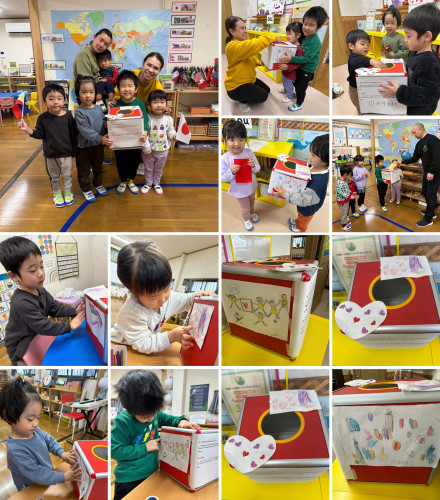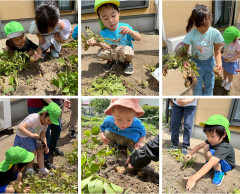日記/Diary
クリスマス・チャリティープログラム「Giving and Sharing」
12月12日、当スクールではフィリピンのSure Step Learning Centerと協力して、クリスマス・チャリティープログラム「Giving and Sharing」を行いました。
この心温まる活動は、子どもたちが「人を助ける喜び」や「思いやりを分かち合う大切さ」を学ぶ貴重な機会となりました。
チャリティーの前には、「与えること」「思いやること」「感謝すること」をテーマに、子供たちにもわかりやすいお話をしました。子どもたちは温かく素直な心でこの活動の目的を理解していきました。
また、寄付箱は子どもたちが作り、心を込めて飾り付けをしました。寄付が入れられるたびに満面の笑顔で「ありがとう!」と声をかける子どもたちを見て、思いやりや感謝の気持ちが自然に育っていることを感じました。
集まった寄付金は、提携校を通じて孤児院の子どもたちへ届けられ、食事やミルク、日用品などの支援に役立てられます。
小さな手から始まったこの活動は、子どもたちにとって大きな学びとなりました。
このような意義深い機会を共に創ってくださったSure Step Child Learning Centerの皆さまに、心より感謝いたします。
Last December 12, our school held a Christmas Charity Program, “Giving and Sharing,” in collaboration with Sure Step Learning Center in the Philippines.
This meaningful activity gave our preschool children a chance to learn the joy of helping others and sharing kindness.
Before the charity event, the children had simple lessons about giving, caring, and gratitude, helping them understand the purpose of the program with warm and open hearts.
The children also created and decorated the donation box themselves.
Each time a donation was placed inside, they smiled brightly and cheerfully said, “Thank you.” In those moments, we saw compassion, empathy, and appreciation growing naturally.
All collected donations were sent through our partner school and will be used to support children in an orphanage by providing meals, milk, and other daily necessities.
What began with small hands became a big lesson in kindness and generosity.
Our heartfelt thanks to Sure Step Child Learning Center for making this meaningful exchange possible.

小さな優しさから生まれた大きな学び/A Small Act of Kindness, A Big Lesson Learned
先週、子どもたちと公園へ向かう途中で、近くの神社の前を通りかかりました。
そこではご年配の方々が落ち葉の掃除をしていらっしゃいました。
いつものように、子どもたちは元気よく「おはようございます!」とごあいさつをして、子どもの1人が興味をもって「なにをしているの?」と声をかけました。
その方は微笑みながら「お掃除をしているんだよ。よかったら手伝ってくれる?」と答えました。
冗談でおっしゃっているのか、本当に助けを必要としているのかわからなかったのですが、子どもたちはすぐに私のほうを見て、目を輝かせながら私の反応を待っていました。
そこで私は、「みんなはどうしたい? お手伝いしたい? それとも、いつも通り公園で遊びたい?」と聞いてみました。
すると、子どもたちはそろって「お手伝したい!」と、迷いなく答えました。その姿を見て、私はとてもうれしくなりました。
前の日に、思いやりや優しさ、人を助けることについてお話をしていたので、その学びが子どもたちの心にしっかり届いていたのだと感じました。
子どもたちは楽しそうに落ち葉を集めて一生懸命お手伝いをしました。
掃除が終わって「手伝ってくれたおかげで早く終わったよ、ありがとう」と言われると、子どもたちは誇らしそうにニコニコしていました。最後には一緒に写真も撮りました。
笑顔とチームワークにあふれた素敵な40分間になり、「誰かの力になれたとき、自分の心まで温かくなって、その想いは相手の笑顔として返ってくる」という大切な学びを実体験を通して得ることができました。
このような経験を通じて、学びは教室の中だけでなく、日常の中の実体験や思いやりのある行動からも育まれることを改めて実感しました。
About a week ago, while walking to the park, we passed by a nearby shrine where some elderly men were cleaning the fallen leaves.
As usual, the children cheerfully greeted them, saying, “Ohayo gozaimasu! Good morning!” One child curiously asked, “What are you doing?” The man smiled and replied, “We’re cleaning up. Do you want to help us?”
We weren’t sure if he was joking or truly needed help, but the children immediately looked at me, their eyes glowing, waiting for guidance.
So I asked them, “What do you want to do—help them, or go to the park and play as we usually do?” To my surprise, everyone answered loudly and confidently, “We want to help!” At that moment, I realized what a meaningful opportunity this was.
Just the day before, we had lessons about emotional and social skills—kindness, empathy, and helping others.
I truly believe that those lessons made an impact and guided the children’s choice that day.
The children happily helped clean the leaves, and when the men thanked them and said the work was finished faster because of their help, the children beamed with pride. We even took photos together.
It turned into a wonderful 40-minute experience filled with joy, teamwork, and an important life lesson: helping others makes us feel good and brings genuine smiles to the faces of those we help.
Moments like these remind us that learning doesn’t only happen inside the classroom—it happens through real experiences and kind actions.

さつまいも掘りの体験をしました
先週、私たちは学校の近くにあるシスターの畑でとても楽しい時間を過ごしました。今回は2回目の収穫体験で、前回はじゃがいも、そして今回はさつまいもです!
子どもたちは土を掘るのに夢中になり、自分で掘ったさつまいもをお家に持ち帰ってお母さんに見せることをとても嬉しそうにしていました。
子どもたちにこんなに楽しく心に残る体験をさせてくださったシスターのご厚意に、心から感謝しています。
Last week, we had a wonderful time at Sister Nakami’s garden near our school.
It was our second harvesting experience — last time it was potatoes, and this time sweet potatoes!
The children were so excited digging in the soil and even happier to take home their very own harvest to share with their mums.
We are truly grateful to Sister Nakami for her kindness and for giving our little ones such a joyful and memorable hands-on experience.

ハロウィンパーティーを開催しました
10月26日、ハロウィンパーティーを開催しました。
今回はかわいいプリスクールの子どもたちと保護者の皆さま、そして元気いっぱいのアフタースクール生の2グループに分かれて楽しみました。
プリスクールの子どもたちは、3曲のハロウィンダンスをとっても上手に披露!
歌いながらノリノリで踊ってくれて、会場中が笑顔でいっぱいになりました。
ゲームも大盛り上がりで、手作りクッキーをはじめとしたおいしいおやつも大好評でした。
どの時間もワクワクがつまった、とても楽しいハロウィンになりました。
ご参加いただいた保護者の皆さま、生徒の皆さん、本当にありがとうございました!
皆さんのおかげで、笑顔あふれる素敵なイベントになりました。
What a spook-tacular Sunday it was!
Last October 26, we celebrated our School Halloween Party with two groups — our adorable preschoolers with their parents and our energetic After School (Jyuku) students!
Our preschoolers confidently performed three fun Halloween dances, singing along with the music and filling the room with smiles and excitement.
Everyone had a great time playing many exciting games, and of course, the homemade cookies and other treats made the celebration even sweeter!
A big thank-you to all the parents and students for joining and making our Halloween event so joyful and full of laughter!


ジャガイモの収穫体験をしました
少し遅れた投稿ですが、思い出としてシェアしたいと思います!
7月に私たちは親切な隣人のナカミさん(引退されたモンテッソーリ教師)のご厚意で、お庭でジャガイモを収穫する体験に招待していただきました。
小さな手で土を掘って土の中に隠れたジャガイモを見つけると、子どもたちの目がキラキラと輝いて嬉しそうな声があちこちで響きました。
この体験は、単なる収穫にとどまらず、自然の恵みや他者の優しさを感じ、子どもたちに大切なことを学ばせてくれました。
Back in July, our preschoolers were warmly invited by our kind neighbor, Sister Nakami, a retired Montessori teacher, to experience harvesting potatoes in her garden.
With little hands eager to dig, the children were amazed to find potatoes hiding beneath the soil.
Their laughter and excitement filled the garden as they collected the harvest together.
This special invitation not only gave the children a joyful hands-on experience, but also taught them to appreciate the blessings of nature and the generosity of others.
(A late post, but a memory worth sharing!)


